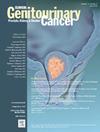Neoadjuvant PD-1/PD-L1 Inhibitors for Muscle-Invasive Bladder Cancer: A Meta-Analysis
IF 2.7
3区 医学
Q3 ONCOLOGY
引用次数: 0
Abstract
Neoadjuvant immune checkpoint inhibitors have emerged as a potential treatment option for muscle-invasive bladder cancer (MIBC), but their comparative efficacy and safety remain unclear. This meta-analysis evaluated pathological outcomes and adverse events of neoadjuvant PD-(L)1 inhibitors across different therapeutic approaches. A systematic search was conducted across multiple databases (PubMed, Embase, Cochrane Library, China National Knowledge Infrastructure, and Wanfang databases), from their inception to December 21, 2024, for studies investigating neoadjuvant PD-(L)1 inhibitors in patients with MIBC. Primary outcomes included pathological complete response (pCR), pathological partial response (pPR), downstaging (DS), and grade ≥3 immune-related adverse events (irAEs). Random-effects models were used to calculate pooled estimates, with subgroup analyses performed based on treatment strategy and inhibitor type. Twenty-nine studies were finally included, involving 33 treatment arms. The overall pooled pCR rate was 32.7% (95% confidence interval [CI]: 27.7%-37.7%), with PD-(L)1 inhibitors plus chemotherapy showing the highest rate (39.2%, 95% CI: 32.1%-46.3%), followed by dual checkpoint inhibition (27.6%, 95% CI: 15.5%-39.6%), and monotherapy (24.6%, 95% CI: 16.9%-32.3%). The overall pooled pPR was 45.3% (95% CI: 38.4%-52.2%), and DS rate was 62.9% (95% CI: 53.1%-72.8%). Grade ≥3 irAEs varied significantly by approach: 9.4% (95% CI: 6.0%-12.7%) for monotherapy, 24.9% (95% CI: 9.6%-40.2%) for dual checkpoint inhibition, and 14.2% (95% CI: 6.9%-21.5%) for combination with chemotherapy. Sensitivity analyses confirmed the robustness of these findings. Neoadjuvant PD-(L)1 inhibitors demonstrate promising efficacy in MIBC with acceptable toxicity profiles. Combination with chemotherapy provides the highest pathological response rates with moderate toxicity, while monotherapy offers a favorable safety profile that may benefit cisplatin-ineligible patients. These findings support the continued investigation of these approaches in ongoing Phase III trials.
新辅助PD-1/PD-L1抑制剂治疗肌肉浸润性膀胱癌:荟萃分析
新辅助免疫检查点抑制剂已成为肌肉浸润性膀胱癌(MIBC)的潜在治疗选择,但其相对疗效和安全性尚不清楚。这项荟萃分析评估了新辅助PD-(L)1抑制剂在不同治疗方法中的病理结果和不良事件。系统检索多个数据库(PubMed, Embase, Cochrane图书馆,中国国家知识基础设施和万方数据库),从其成立到2024年12月21日,研究新辅助PD-(L)1抑制剂在MIBC患者中的应用。主要结局包括病理完全缓解(pCR)、病理部分缓解(pPR)、降低分期(DS)和≥3级免疫相关不良事件(irAEs)。随机效应模型用于计算汇总估计,并根据治疗策略和抑制剂类型进行亚组分析。最终纳入29项研究,涉及33个治疗组。总的聚合pCR率为32.7%(95%可信区间[CI]: 27.7%-37.7%),其中PD-(L)1抑制剂加化疗的发生率最高(39.2%,95% CI: 32.1%-46.3%),其次是双检查点抑制(27.6%,95% CI: 15.5%-39.6%)和单药治疗(24.6%,95% CI: 16.9%-32.3%)。总合并pPR为45.3% (95% CI: 38.4% ~ 52.2%), DS率为62.9% (95% CI: 53.1% ~ 72.8%)。≥3级irae在不同的治疗方法中差异显著:单药治疗为9.4% (95% CI: 6.0%-12.7%),双检查点抑制为24.9% (95% CI: 9.6%-40.2%),联合化疗为14.2% (95% CI: 6.9%-21.5%)。敏感性分析证实了这些发现的稳健性。新辅助PD-(L)1抑制剂在MIBC中显示出良好的疗效,并且具有可接受的毒性。联合化疗提供了最高的病理反应率和中等毒性,而单药治疗提供了有利的安全性,可能有利于顺铂不合格的患者。这些发现支持在正在进行的III期试验中继续研究这些方法。
本文章由计算机程序翻译,如有差异,请以英文原文为准。
求助全文
约1分钟内获得全文
求助全文
来源期刊

Clinical genitourinary cancer
医学-泌尿学与肾脏学
CiteScore
5.20
自引率
6.20%
发文量
201
审稿时长
54 days
期刊介绍:
Clinical Genitourinary Cancer is a peer-reviewed journal that publishes original articles describing various aspects of clinical and translational research in genitourinary cancers. Clinical Genitourinary Cancer is devoted to articles on detection, diagnosis, prevention, and treatment of genitourinary cancers. The main emphasis is on recent scientific developments in all areas related to genitourinary malignancies. Specific areas of interest include clinical research and mechanistic approaches; drug sensitivity and resistance; gene and antisense therapy; pathology, markers, and prognostic indicators; chemoprevention strategies; multimodality therapy; and integration of various approaches.
 求助内容:
求助内容: 应助结果提醒方式:
应助结果提醒方式:


